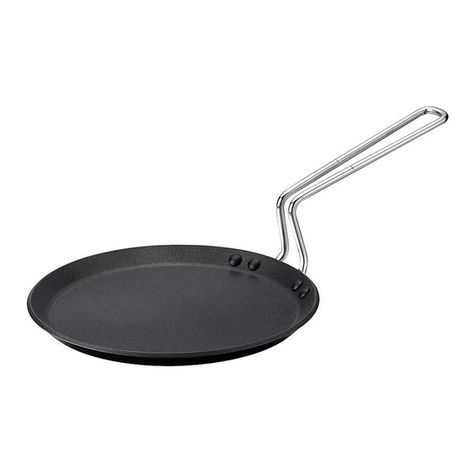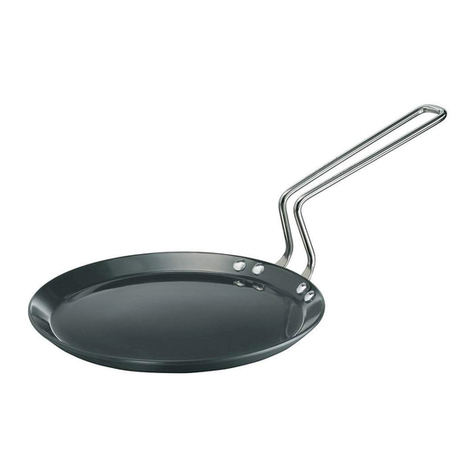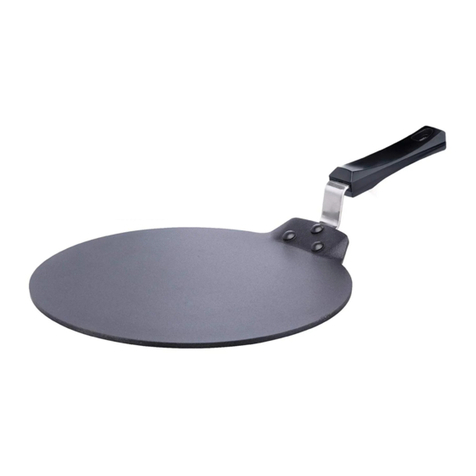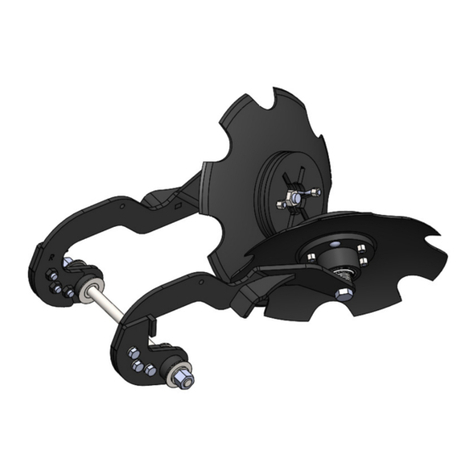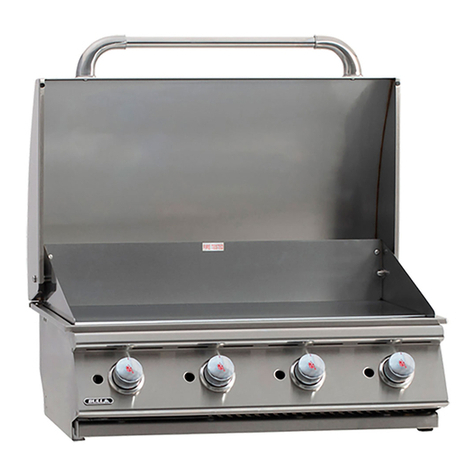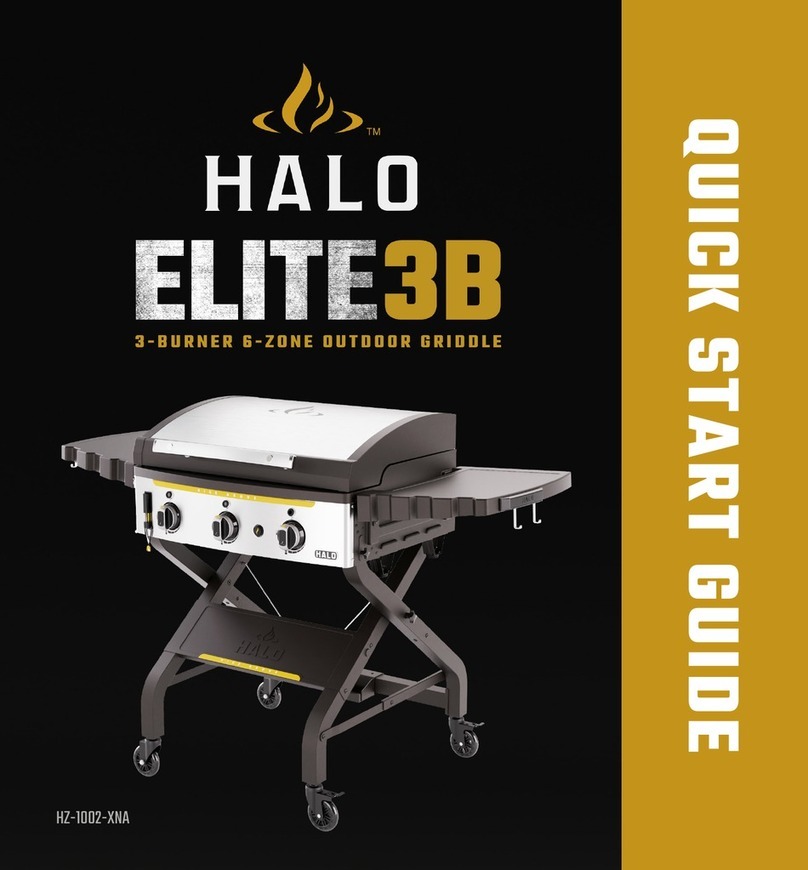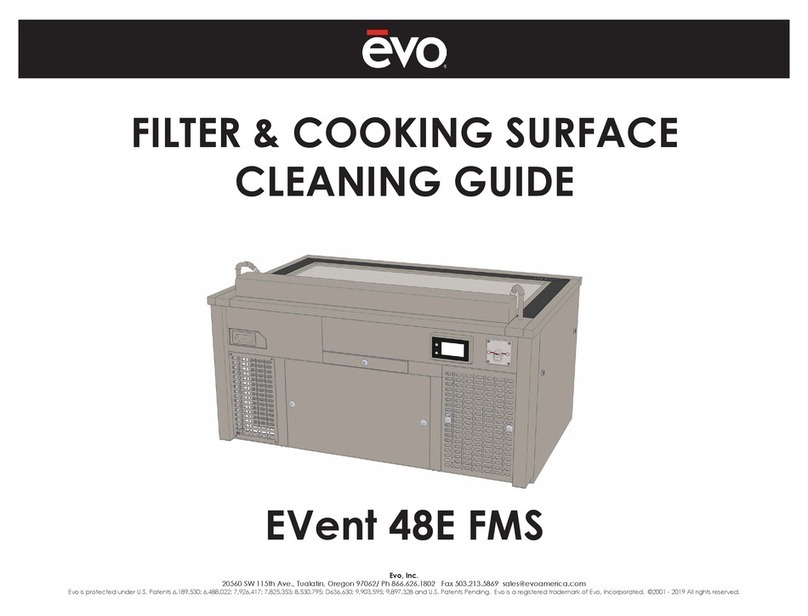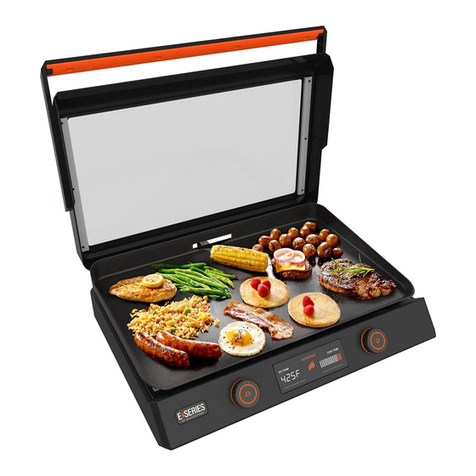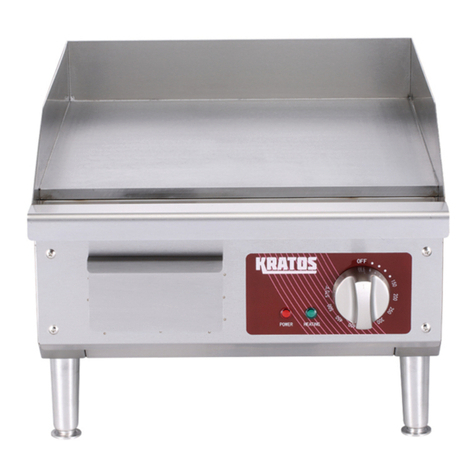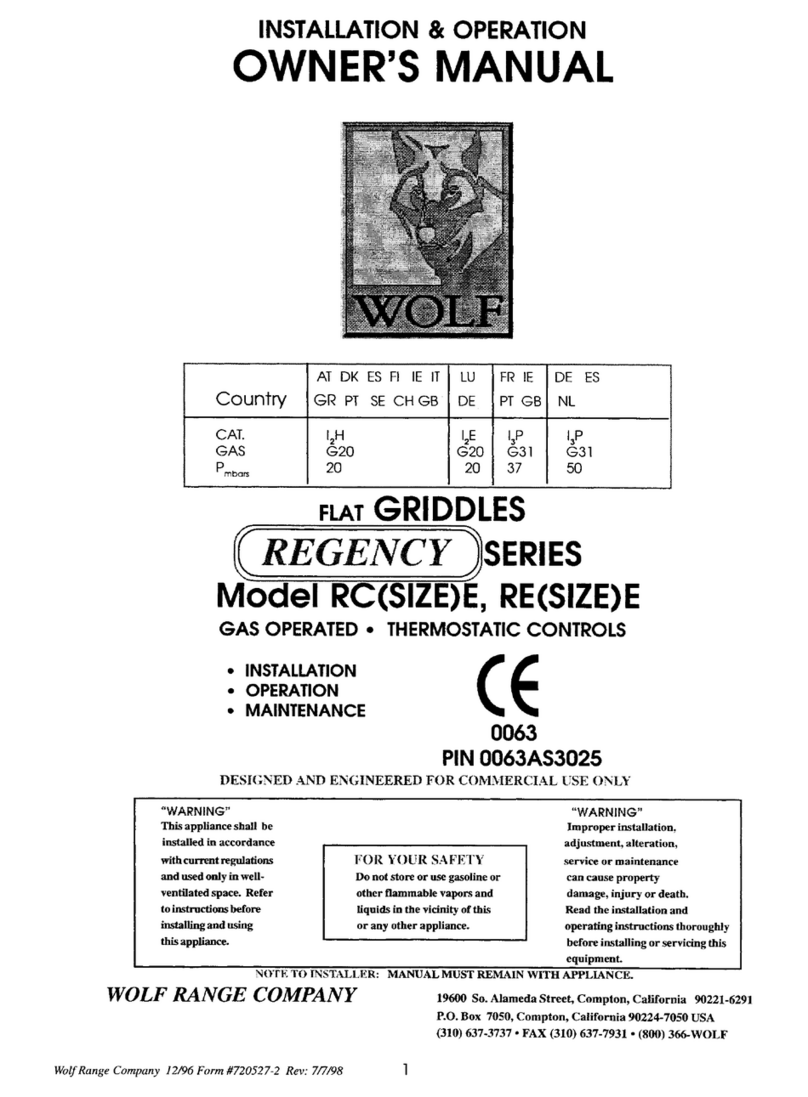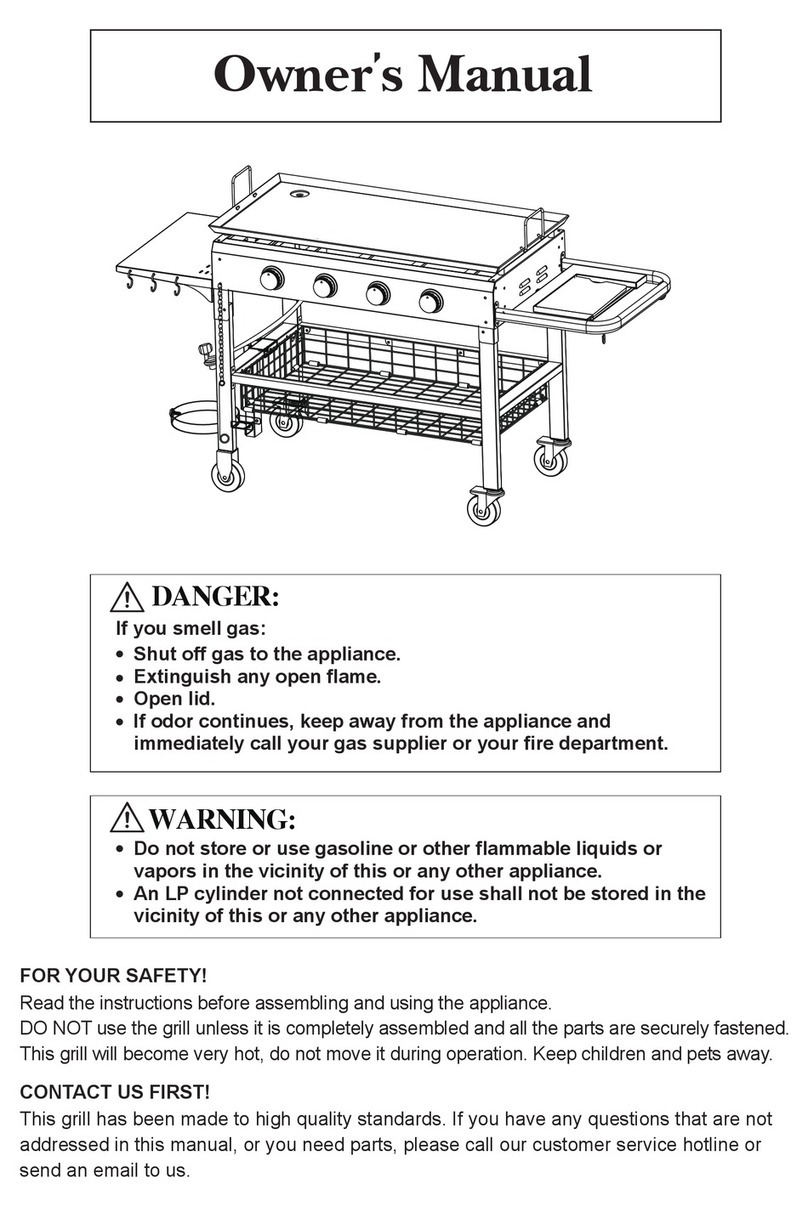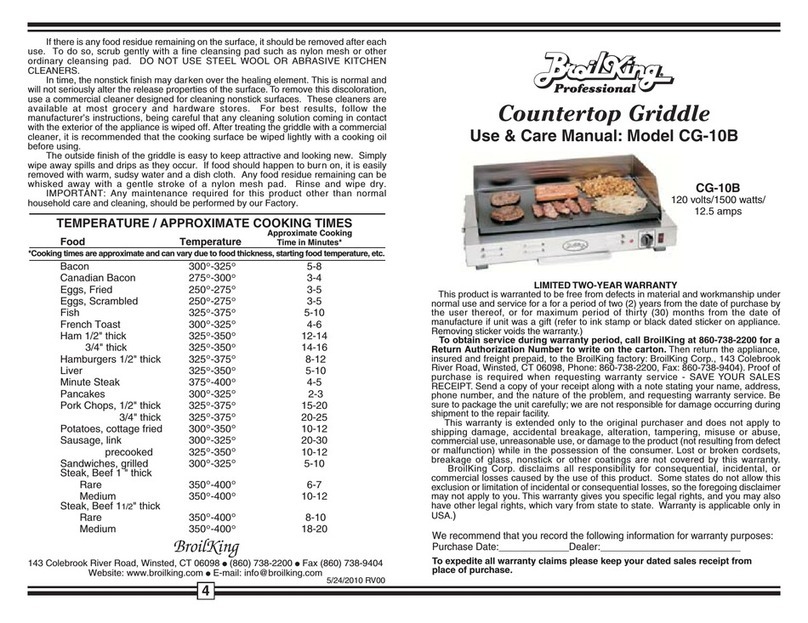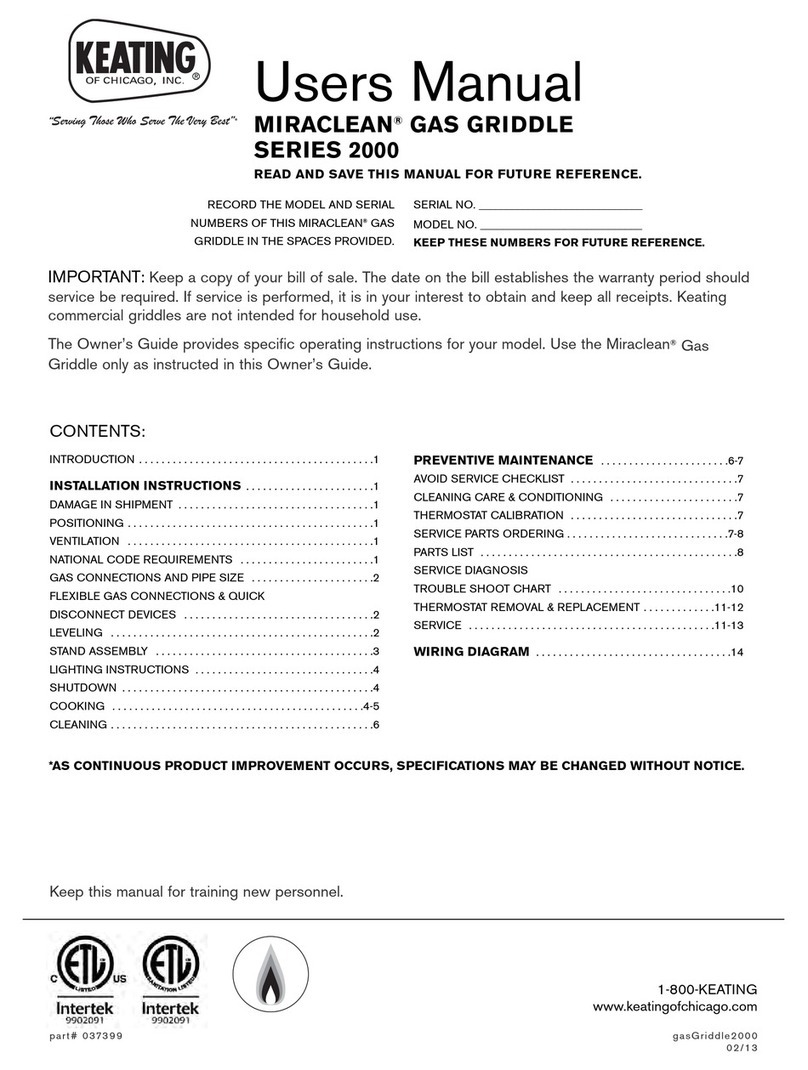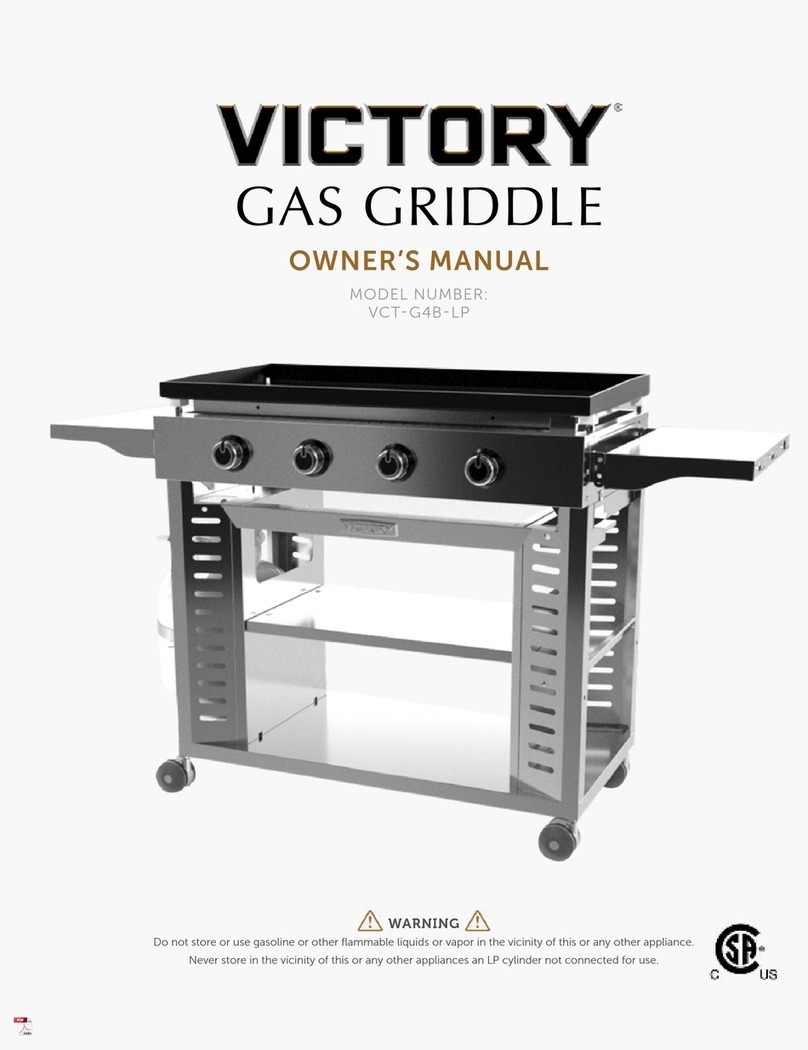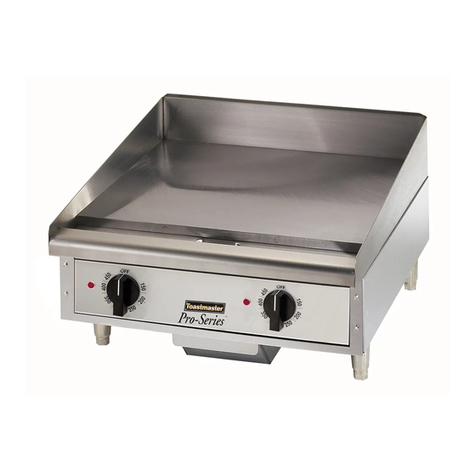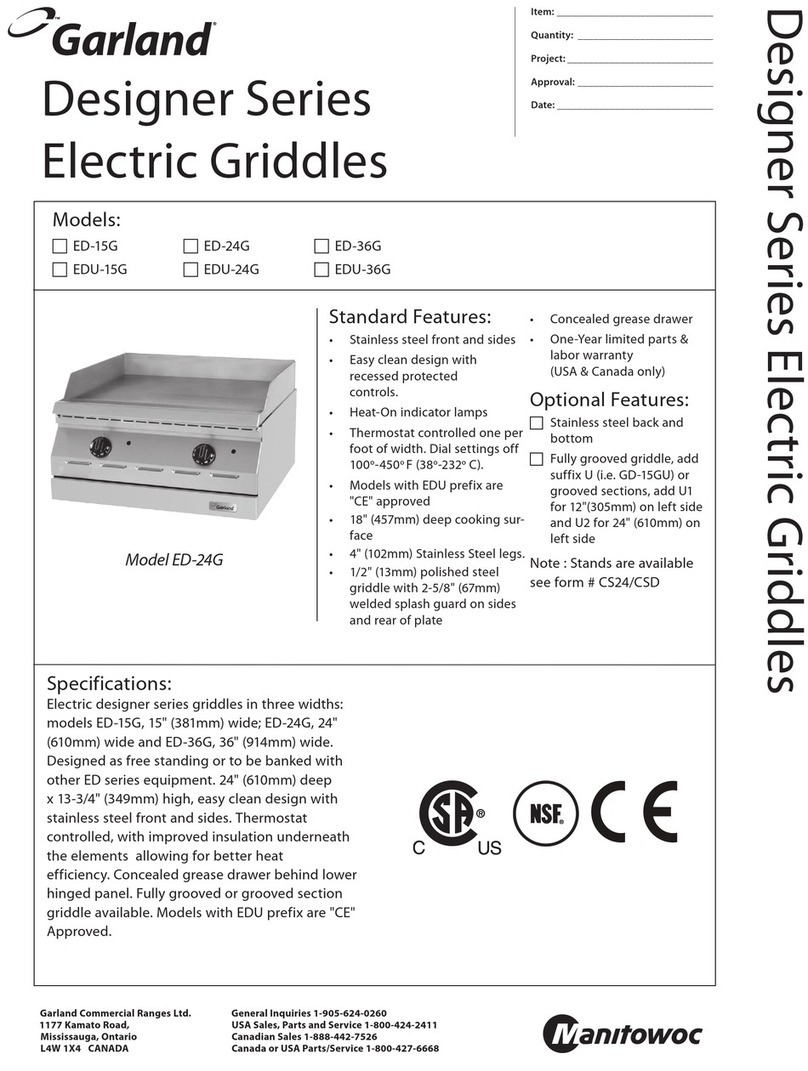Hawkins Futura Nonstick Tava Griddle User manual


1
IMPORTANT SAFEGUARDS
1. Do not use high heat.
2. Do not use on chulha, industrial burners
or any heat source which cannot be
regulated to low and medium heat.
3. Limit preheating without food to 3 minutes
for the 22 cm tava and 4 minutes for the
26 cm tava on medium heat.
4. When tava is hot, ensure that it is never
without food.
5. Do not cut on tava or scrape it with metal
or sharp edged objects.
6. Clean thoroughly after each use in hot
water with a mild soap or detergent and a
dishcloth or sponge. Do not use abrasive
cleaning agents or scrubbers.
7. Do not put hot tava in cold water.
8. Do not wash tava in a dishwasher.
9. Do not put tava in a hot oven or under a
broiler.
10. The handle of tava should be parallel to
the kitchen counter – not sticking out.
11. Always give careful attention to a hot tava,
hot oil and flame/heat.
12. Do not leave frying unattended.
13. Do not drop food or other objects from
a height on the tava particularly when it
has hot oil or butter. Gently place food
on the tava to avoid splashing of the
contents.
14. Read and follow instructions in this
Manual.
1

2
Contents
Important Safeguards
Page
1
Introduction 2
How to Use 3
How to Clean 5
Easy Tips for Better Cooking 6
How to Stuff
Paratha
7
How to Cook
Paratha
7
Recipes
Channa Dal Paratha (Unleavened Bread Stuffed
with Bengal Gram) 8
Welsh Griddle Cakes 9
Gobi Paratha (Unleavened Bread Stuffed
with Cauliflower)
10
Makai ki Roti (Corn Meal Flat Bread) 11
Phulka (Puffed Unleavened Bread) 11
Paratha (Layered Unleavened Bread) 12
Paneer Tikki (Cottage Cheese Cutlets) 13
Puran Poli (Sweet Stuffed Unleavened Bread) 14
Alu Paratha (Unleavened Bread Stuffed
with Potatoes) 15
Pudina Paratha (Layered Unleavened Bread
with Mint) 16
Glossary (Meanings and Methods) 17
How to Contact Us 18
Introduction
Futura Nonstick Cookware
Futura Nonstick Cookware is made with a patented process
by which high quality nonstick coating is fixed on to a hard
anodised surface which makes it most durable. Futura
Nonstick Cookware comes in many useful shapes and sizes to
suit your different cooking needs. All are made from heavy
gauge, pure, virgin aluminium for fast and even heat
conduction. The pans are well-balanced with sturdy, stay-cool
handles. The bottom and outer sides are hard anodised to give
you a surface that will not tarnish, pit or corrode and will stay
looking new for years.
Futura Nonstick Tava (Griddle)
This Manual contains instructions and 10 recipes for the
three Futura Nonstick Tava (Griddle): 22 cm diameter,
26 cm diameter (4.06 mm thick) and 26 cm diameter (4.88 mm
thick). The size and thickness of the tava is stamped on the
underside of the tava. Specific instructions for a particular size
are given when required. Your tava will give you years of easy,
great-tasting, healthful, economical cooking and easy clean-up
if you carefully follow the instructions in this Manual.
Futura Nonstick Flat Tava (Griddle)
Also available in the Futura Nonstick Cookware range are
three flat tava: 26 cm diameter with stainless steel handle,
26 cm diameter with plastic handle and 30 cm diameter with
stainless steel handle – which have their own Manual.
‘
Hawkins’ and ‘
Futura’ are registered trademarks in 18 and 23 countries respectively. Product Design Registered in India. 2003 Copyright Reserved by Hawkins
Cookers
Limited.
Edited and published by Brahm Vasudeva on behalf of Hawkins Cookers Limited, Maker Tower F-101, Cuffe Parade, Mumbai 400 005, India and printed in 2003 at Rite Print Pak,
Mumbai.

3
How to Use
Wash Before Use
Remove sticker/label. Remove any adhesive with baby or
vegetable oil. Before using tava for the first time, wash in hot
water with a mild soap or detergent, rinse in clear water and
dry. Do not wash in a dishwasher.
Seasoning
It is not necessary to season the tava. If, however, you plan
to cook food which tends to stick such as fried eggs without
any oil or butter for the first use or before you have cooked
with oil on the tava, seasoning will assist release of the food.
To season: rub 1 teaspoon (5 ml) vegetable oil over the clean
nonstick surface using a paper napkin or clean cotton cloth.
Wipe off oil with a paper napkin or clean cotton cloth. Wash
and dry tava.
Suitable Heat Sources
High temperatures will shorten the life of the nonstick and
may destroy it. Use tava only on domestic gas, electric or
halogen stoves in which the temperature can be regulated to
low and medium heat. Do not use high heat.Use low to
medium heat.
Limit Preheating of Tava
Some foods require preheating of the tava. Foods such as
phulka and paratha require the tava to be at a certain
temperature before you cook the first batch.
When preheating the cold empty tava (with or without
oil) before beginning to cook, it is critical that THE
HEAT IS NO MORE THAN MEDIUM and the time is
strictly limited to no more than the following:
Tava Maximum Preheating Time
22 cm 3 MINUTES
26 cm 4 MINUTES
The actual time required for preheating for best cooking
results may be less, depending on the food being cooked and
your burner. Overheating can occur quickly if the tava is left
on the heat without food so NEVER keep the tava empty on
the heat once it is hot.
Avoid Overheating: Check Your Burner
If food is smoking or burning, reduce heat. Using medium
or lower heat and limiting the time the empty tava is heating
are the basic techniques to avoid overheating.
The tava can overheat even on medium heat if the
burner is providing excessive heat. To check if your burner
can overheat even on medium heat, place clean tava on
medium heat. Heat tava for 2 minutes. Press one finger firmly
into whole wheat flour (atta).Do not pinch. Flick from a
distance of about 6 cm a small, fine, even dusting of flour on
centre of tava and immediately begin counting off seconds
(“one second, two second, three second” etc.) while watching
the flour. The time the flour takes to become dark brown
gives a rough indication of how hot the tava is. As long as flour
has not turned dark brown within 15 seconds, the tava is not
overheated. Follow the steps in the chart on the next page to
complete the test. Do not exceed the preheating limit of
3 minutes for 22 cm tava and 4 minutes for 26 cm tava in any
case.

4
Flour turns
dark brown in
15 seconds or
less?
Tava is… Action needed
A. Yes Overheated 1. Remove tava from heat at
once.
2. Reduce heat setting.
3. Try again when tava has
cooled.
B. No Not
overheated
1. Continue heating tava for one
more minute. Repeat flour
test.
2. If flour turns dark brown in
15 seconds or less, tava is
overheated: follow action as
per A.
3 a. For the 22 cm tava: If
flour does not turn dark
brown in 15 seconds or less,
the heat setting is all right for
preheating. Stop the test.
b. For the 26 cm tava: If
flour does not turn dark
brown in 15 seconds or less,
continue heating tava for one
more minute. Repeat flour
test. If flour turns dark brown
in 15 seconds or less,
tava is
overheated: follow action as
per A. If flour does not turn
dark brown in 15 seconds or
less, the heat setting is all right
for preheating. Stop the test.
Avoid Scratching, Damage
Use wooden, heat-resistant nylon, plastic or rubber
spatula/utensils. Metal utensils will scratch and reduce the life
of the nonstick coating. Do not cut or scrape with metal
objects or knives. If using a metal spatula, try to keep spatula
parallel to the tava to avoid digging into the coating. Try to
touch the food and minimise contact with the coating. Do not
leave plastic, nylon or rubber utensils on tava while it is hot.
Do not hit the tava or bang its rim. Do not bang tava down
on pan supports. Lift tava from the pan supports – do not
drag it across the pan supports. When storing the tava ensure
that the nonstick coating is not gouged or rubbed against any
hard or sharp surface. Do not stack other utensils on the
coating without protecting it.
After use, faint scratches or marks may appear on the
nonstick coating. These are marks of normal wear and do not
affect the performance of the coating. Even if some of the
coating is scraped off, the tava is still safe to use. The coating
is non-toxic and inert; if accidentally and unknowingly ingested,
it passes through the body harmlessly.

5
How to Clean
Wash After Every Use
Taking care to protect your hand from the hot tava with
sufficient paper or cloth, wipe off residual oil with a paper
napkin or muslin cloth from hot tava immediately after
cooking. Doing so makes cleaning very much easier.
Always wash tava thoroughly after every use in hot water
with a mild soap or detergent and a dishcloth or sponge. Do
not wash tava in a dishwasher. Let tava cool before immersing
in water. For stubborn spots on the nonstick surface, soak
tava in hot water about 10 minutes and rub with a non-abrasive
plastic scrubber – never use steel wool, coarse or metallic
scouring pads or abrasive detergents. When cleaning the tava
ensure that the nonstick coating is not gouged or rubbed
against any hard or sharp surface. While cleaning, keep a
folded kitchen cloth or a piece of any other soft material such
as rubber or sponge underneath the tava to avoid damaging the
tava. Dry thoroughly with a soft clean cloth.
Wash wooden spatula in hot water with a mild soap or
detergent, rinse and dry immediately – do not soak.
Metallic marks – most often from gas stove pan supports –
may appear on the hard anodised base. To remove metallic
marks from base: apply a kitchen cleanser, such as Vim, to the
marks and rub with an abrasive kitchen scrubber, such as
Scotch-Brite or fine steel wool.
Avoid “Baked-On” Food
If tava is not cleaned thoroughly, a thin layer of food or
grease may remain. When the tava is heated next this
food/grease becomes “baked-on” and very difficult to remove.
“Baked-on” food may be impossible to remove without
damaging the tava.
If you get “baked-on” food, you may try the following
methods knowing that the tava surface may get damaged:
On the Hard Anodised (Bottom Surface): Make a thick
paste of a cleaning powder such as Vim and apply it to the
surface. Wait 5 to 10 minutes. Scour with steel wool using a
circular motion. Wash.
On the Nonstick (Top/Cooking Surface): Make a thick
paste of a cleaning powder such as Vim and apply it to the
“baked-on” food. Wait 5 to 10 minutes. Scour with a plastic
scrubber using a circular motion. Wash.

6
Easy Tips for Better Cooking
1. All measurements used in these recipes are level, not
heaped.
1 teaspoon = 5 ml
1 tablespoon = 15 ml/3 teaspoons
14cup = 60 ml/4 tablespoons
13cup = 80 ml/5 tablespoons + 1 teaspoon
12cup = 120 ml/8 tablespoons
34cup = 180 ml/12 tablespoons
1 cup = 240 ml/16 tablespoons
Abbreviations
gm = gram cm = centimetre ml = millilitre
2. Read the entire recipe before beginning to work.
Assemble and prepare all ingredients. Follow recipe step-by-
step.
3. Before putting the tava on the heat, prepare all ingredients
and keep spatula, utensils, serving plate etc. ready in the
cooking area. If you are looking for things once the tava is
on the heat, it can overheat quickly and destroy the
nonstick coating.
4. Time and heat settings in these recipes refer to the large
burner of an efficient domestic gas stove. (For the 22 cm
diameter tava, use the small burner.) You may have to adjust
these times and settings to suit your stove. For best cooking
results, adjust the heat so that cooking times are the same as
those given in the recipes. You will be helped in making these
adjustments by the steps and indications given in various
recipes (for example, a few light brown specks should appear
on the underside of a paratha after 1½ minutes on medium
heat). Avoid high temperatures for the best cooking results,
conserving fuel and preserving the life of the nonstick coating.
5. Adding a little oil or butter to the tava may enhance the
colour, taste and texture of many foods.
6. The quantities of green chillies recommended in the
recipes are calculated to produce food of moderate pungency.
You may increase, reduce or eliminate the chillies according to
your taste.
7. Eggs require controlled heat or they may become tough.
Eggs should be cooked on low to medium temperatures.
Higher heat hardens the protein, resulting in rubbery eggs.
8. The nonstick coating of the tava retards browning
somewhat in certain foods. For browner results, try cooking
slightly longer. Do not use high heat.
9. Eggs, batters, doughs and fillings should be at room
temperature before beginning to cook.
10. To prevent sticking when rolling out rounds of dough:
slightly flatten balls and press the balls/coils lightly in flour on
both sides. Shake off excess flour and roll out.
11. While cooking on tava, paratha and phulka leave a residue
of flour that will burn. Using a kitchen cloth wipe off
accumulated residue after every third roti.
12. If you come across a word in the recipes which you do not
understand, please check Glossary (Meanings and Methods)
page 17.

7
HowtoStuff
Paratha
THESEINSTRUCTIONSARETO BEUSED ASINDICATED IN CERTAIN RECIPES.
1. Place round onpalm ofhand. Cup hand slightlyto forma
depression in centreofround (FigureA).
2. Put amount offillingspecifiedinrecipeon round. Except
potato, lightlypatfilling,spreadingevenlyto ½cmfrom edge
ofround (FigureB).
3. Surround fillingevenlywith doughbygentlyopeningand
closinghand slightlyinapulsatingmotion till someedgesjust
meet. Pinchtogethertheedgeswhichmeetjustenoughto seal
(FigureC). Patsealedarea to getaneventhickness ofdough.
Repeat till round isclosed fully.
4. Place stuffedround on board. Flattenslightly.Stuff
remainingroundsofdoughin thesameway.Keepcovered
with adamp cloth.
5. On aflouredboard, roll eachstuffedball gentlyinto aflat
round 15 cmin diameter.Keepon alightlyflouredsurface,
covered with adamp cloth.
HowtoCook
Paratha
THESEINSTRUCTIONSARETO BEUSED ASINDICATED IN CERTAIN RECIPES.
1. Put round onpreheatedtava.Cook 1½minutes.Top
should begin to look dryand darken. (Thereshouldbeafew
light brown speckson theunderside.)
2. Turnoverwithawoodenspatula.(If you canadjustthe
heatsothatafew light brownspecksappearon theunderside
in 1½minutes, you will becookingattheideal temperature.)
3. Spread ½teaspoonghee all overtop surface ofround.
4. Turnover. Spread ½teaspoon ghee in thesameway.
5. Turnover.Lightlypressentireround with spatula,
rotatingand pressingasmall area atatime.(Pressing
paratha/makaiki roti ensuresevencooking.If younotice a
lighterarea,press ontheoppositesideofthatarea whenyou
haveturned over paratha/makai ki roti.)
6. Turnover. Pressin thesameway.
7. Turnover. Spread ½teaspoon ghee overround.
8. Turnover. Spread ½teaspoon ghee overround.
9. Turnover.Continuepressingand turningtill
paratha/makaiki roti isevenlybrowned(medium-brown) on
both sides.(Paratha takeabout 4minutesto cook; stuffed
paratha takeabout 6minutes; makaiki roti takeabout
7 minutes.)
FigureA
FigureB
FigureC

8
ChannaDalParatha(UnleavenedBread
Stuffedwith BengalGram)
Yield: 12 paratha
Filling
2 cups+3 tablespoons
(525 ml)
water
118cups(225gm) Bengal gram soaked in
2 cupswaterfor15 minutes
and drained
134teaspoons salt
14teaspoon turmeric powder
1 medium (120 gm) onion finelychopped
1 x 2.5 cm piece (5 gm) ginger finelychopped
4greenchillies finely
chopped
14 cup corianderleaves finely
chopped
Dough
4 cups(400 gm) siftedwheatflour
12teaspoon salt
113cups+1 tablespoon
(335 ml)
water
Ghee forFrying
12cup (120 gm)
1. Tomake filling: Bringwatertoboil inamedium panon
highheat. Add gram, salt and turmericpowder.Stir.Bringto
boil. Reduce heatto low.Coverandcook till gramistender
but not mushy(about35 minutes). Meanwhile,do step2.
Drain offexcesswater,ifany.Allowto cool. Addremaining
ingredients.Mix.
2. Tomake dough:Mix flour,salt and 1cupwater.Add
enoughofremainingwater(6 tablespoons), 2tablespoonsata
time,mixingaftereachaddition, till doughformsasoftball
(stopaddingwaterbeforedoughbecomeswetand sticky).
Kneadtill doughissmooth and elastic(about 2minutes).
Keep covered with adamp cloth about 30 minutes.
3. Rub handswithalittleghee.Kneaddoughbriefly.Make
12 ballsabout 4cmin diameter.Keepcoveredwithadamp
cloth.
4. On aflouredboard, roll eachball ofdoughinto aflat
round 10 cmin diameter(see page 6para10). Keepcovered
with adamp cloth.
5. Tostuff
paratha
:Followillustratedstepson page 7,
using 14cup offillingforeach round ofdough.
6. Heattavaon medium heatabout 2minutesfor22 cm
tava/about 3 minutesfor26 cm tava.
7. Put round ontava.Cook asexplainedon page 7. Cook
remainingroundsin thesameway.Servehot, accompanied
with curd. h

9
WelshGriddleCakes
Yield: 15 cakes
134cups(200gm) refinedflour
2 teaspoons baking powder
14teaspoon salt
14teaspoon nutmeg powdered (optional)
13cup +112tablespoons
(100 gm)
coldbutter cut into 1.5 cm
cubesand refrigerated till use
34 cup (100 gm) powderedsugar
13cup (50 gm) raisins
1egg beaten
12to 2 teaspoons milk
1 teaspoon butter
1. Sifttogetherflour,bakingpowder,salt and nutmeg,three
times. Place in large bowl.
2. Add butterinto bowl. Takeasmall portion ofbutterand
flourmixturebetweenfingertipsandthumb ofeachhand.
Raisehandsabout20 cmfrom baseofbowl. Rub butterand
flourmixturebetweenfingersand thumbs;letmixturefall into
bowl. Repeattillall butterisrubbedinand mixtureresembles
finebreadcrumbs.Add sugarand raisins.Mix withafork.
Add egg.Mix with fork. Addand mix enoughmilk,
12teaspoonatatime,till mixturecanbepattedtoformaball.
Do not knead.
3. On aflouredsurface,roll out doughevenlyto about
12cmthick. Cut into roundswith pastrycutterorinverted
bowlorglass7cmindiameter.Useabluntknife/spatulato
lift roundsand place on aflouredsurface.
4. Gathertrimmingsand formaball. Repeat step3 tillall
dough iscut into rounds(about 15).
5. Heattavaon medium heatabout 2minutesfor
22 cm tava/about 3 minutesfor26 cm tava.
6. Reduce heatto low.Spreadbutterall overtava.Quickly
add 5rounds*,leavingthecentrespace free.Cook about
5minuteson eachside(bothsidesshould begoldenbrown).
Cook remainingrounds,5*atatime,onlowheatabout
3minuteson eachsidewithout addingbutter.Servehot orat
room temperatureaccompanied with honey orjam.
*4 roundson the22 cm tava h

10
GobiParatha(UnleavenedBreadStuffed
withCauliflower)
Yield: 12 paratha
Dough
4 cups(400 gm) siftedwheatflour
12teaspoon salt
113cups+1 tablespoon
(335 ml)
water
Filling
3 medium (1.5 kg) cauliflowers leavesand
tough lowerpart ofstems
removed, quartered (750 gm)
5 teaspoons salt
2 medium (200 gm) onions finelychopped
112teaspoons cuminseeds
5greenchillies finely
chopped
14cup corianderleaves finely
chopped
Ghee forFrying
12cup (120 gm)
1. Tomake dough:Mix flour,salt and 1cupwater.Add
enoughofremainingwater(6 tablespoons), 2tablespoonsata
time,mixingaftereachaddition, till doughformsasoftball
(stopaddingwaterbeforedoughbecomeswetand sticky).
Kneadtill doughissmooth and elastic(about 2minutes).
Keep covered with adamp cloth about 30 minutes.
2. Tomake filling: Gratecauliflower.Mix cauliflowerand
salt. Keepaside15 minutes.Squeeze out and discardwater.
Add remainingingredients. Mix.
3. Rub handswithalittleghee.Kneaddoughbriefly.Make
12 ballsabout 4cmin diameter.Keepcoveredwithadamp
cloth.
4. On aflouredboard, roll eachball ofdoughinto aflat
round 10 cmin diameter(see page 6para10). Keepcovered
with adamp cloth.
5. Tostuff
paratha
:Followillustratedstepson page 7,
using512tablespoonsoffillingforeach round ofdough.
6. Heattavaon medium heatabout 2minutesfor22 cm
tava/about 3 minutesfor26 cm tava.
7. Put round ontava.Cook asexplainedon page 7. Cook
remainingroundsin thesameway.Servehot, accompanied
with curd. h

11
Makai ki Roti(CornMealFlatBread)
Yield: 12 roti
4 cups(400 gm) corn meal
214cups(540ml) water
12cup (120 gm) ghee
1. Startthissteponlywhenreadyto cook. Mix cornmealand
112 cupswater.Add enoughofremainingwater (34cup),
2tablespoonsatatime,mixingaftereachaddition, till dough
formsasoftball. Make12 ballsabout 4.5 cmin diameter.
Keep covered with adamp cloth.
2. On awell flouredboard, roll aball ofdoughlightly.Dust
rollingpin from timeto timeto avoid sticking.Sealcracksby
pinchingedgesand continuerollinginto aflatround 14 cmin
diameter.
3. Heattavaon medium heatabout 2minutesfor22 cm
tava/about 3 minutesfor26 cm tava.
4. Put onehandoverround andtip boardtillround drops
onto openpalm.*Putround on tava.Cook till undersidehas
light goldenbrownpatches(about2minutes).Turnoverwith
awoodenspatula.Cook2minutes.Turnover.Continue
cooking,followingsteps3to9ofHowtoCook Parathaon
page 7 till evenlybrowned onboth sides.
5. Roll outand cook remainingballsin thesameway.Roll
out eachball shortlybeforecooking(whileanotherround ison
tava).
6. Servehot, accompaniedwith sarsonkasaag.
*If round sticksto theboard, easeround usingbroadmetal
spatulaand tipboard in thesameway.h
Phulka (PuffedUnleavenedBread)
Yield: 12 phulka
212cups(250gm) siftedwheatflour
12teaspoon salt (optional)
34cup +2 tablespoons
(210 ml)
water
1. Mix flour,saltand 12cup water. Add enoughofremaining
water(6 tablespoons), 2tablespoonsatatime,mixingafter
eachaddition, till doughformsasoftball (stop addingwater
beforedoughbecomeswetand sticky). Kneadtill doughis
smooth and elastic(about 2minutes). Keepcoveredwith a
damp cloth about 30 minutes.
2. With oiledhands,kneaddoughbriefly.Make12 balls
about 3 cm in diameter. Keep covered with adamp cloth.
3. On aflouredboard, roll eachball ofdoughinto aflat
round 14 cmin diameter(see page 6para10). Keepon a
lightlyfloured surface, covered with adamp cloth.
4. Heattavaon medium heatabout 2minutesfor22 cm
tava/about 3minutesfor26 cmtava.Put roundon tava.
Cook till small blisters appearon surface and veryfew light
brownspecksappearon underside(about 15-20 seconds).
Turnover.Cook till brownspecksappearonunderside

12
(about 50 seconds). Turnover.Ifyou areexperiencedwith
thetechnique,you may puff up phulka directlyon theflame.
Otherwise,with afoldedkitchencloth, press edgesof phulka
till phulka puffsup and/orundersidehasbrownspecks(about
30-40 seconds). Cook remainingroundsinthesameway.
Servehot. h
Paratha(LayeredUnleavenedBread)
Yield: 12 paratha
5 cups(500 gm) siftedwheatflour
1 teaspoon salt (optional)
134cups(420ml) water
12cup +2 tablespoons
(150 gm)
ghee
1. Mix flour,saltand 1cup water.Addenoughofremaining
water(
3
4cup), 2tablespoonsatatime,mixingaftereach
addition, till doughformsasoftball (stop addingwaterbefore
doughbecomeswetand sticky). Kneadtill doughissmooth
and elastic(about 2 minutes). Keepcoveredwith adampcloth
about 30 minutes.
2. Rub handswithalittleghee.Kneaddoughbriefly.Make
12 ballsabout 4cmin diameter.Keepcoveredwithadamp
cloth.
3. On aflouredboard, roll aball ofdoughintoaflatround
15 cmin diameter(see page 6para10). Spread 12teaspoon
ghee all overthetopsurface oftheround.
4. Startingatoneedge,tightlyroll up round (FigureA).
With palmsofboth handsroll backand forthtill extendedto
20 cmlong(FigureB). Wind around oneend intoaflatcoil
(FigureC). Put free end overcentretop ofcoil (FigureD).
Pressdownfree end gently. Flatten coilslightly.
5. Makeremainingballsintocoilsinthesameway.Keep
covered with adamp cloth.
6. On aflouredboard, roll eachcoil into aflatround15 cm
in diameter.Keeponalightlyflouredsurface,coveredwith a
damp cloth.
7. Heattavaon medium heatabout 2minutesfor22 cm
tava/about 3 minutesfor26 cm tava.
8. Put round on tava. Cook asexplainedon page 7.
9. Remove paratha fromtava.With papernapkinsorcloth
protectingboth hands,cuphandsaround paratha and quickly
bringtogether(crushing paratha)and release.Rotate paratha
90 degrees.Repeatcrushing.Cook remainingroundsin the
sameway. Servehot. h
FigureA
FigureB
FigureD
FigureC

13
Paneer Tikki (CottageCheeseCutlets)
Yield: 20 tikki
813cups(2 litres) milk
2 tablespoons lemonjuice
2 slices(each 8 cm x 7 cm x
1 cm)
bread
1 cup (240 ml) water
2 tablespoons cornflour
1 small (75 gm) onion finelychopped
14cup corianderleaves chopped
2greenchillies finely
chopped
112teaspoons salt
14teaspoon pepper
5 teaspoons vegetable oil
1. Tomake soft
paneer
:Bringmilk toboil inalarge pan.
Add lemon juice,stirringconstantly(about 1minute)tillmilk
hascurdled(curdseparatedfrom whey). Removepanfrom
heat. Place muslin cloth overabowl. Pourcurdledmilk into
muslin andstrain. Gatherup cornersofmuslinand tieabout
5cmabovecurds.Hangthisbag about30 minutes.Gently
squeeze bag to drain excesswhey.Untiebag.Weigh400 gm
paneer to make tikki.Gentlycrumble paneer.
2. Immerseeach breadslice in waterfor15 seconds.Squeeze
out and discard water. Shred bread into tinypieces.
3. Mix gentlywith fingertips paneer,breadand all other
ingredientsexcept oil. Make20 slightlyroundedpattiesabout
5 cm in diameter, 1 cmthick.
4. Spread1teaspoon oil on tava.Place on medium heat
about 2minutesfor22 cmtava/about 3minutesfor26 cm
tava. Reduce heatto low.Add 4patties.Fryon both sidestill
goldenbrown(about 3minutesoneachside). Remove.Fry
remainingpattiesin thesameway,except do notincreaseor
reduce heat. Servehot, accompaniedwith chutney ortomato
ketchup. h

14
PuranPoli(SweetStuffedUnleavenedBread)
Yield: 18 poli
Dough
134cups(200gm) siftedrefinedflour
14teaspoon salt
apinch turmeric powder
13cup +1 tablespoon +
1 teaspoon (100 ml)
water
14cup +2 tablespoons
(90 ml)
vegetable oil
Filling
1 cup (200 gm) Bengal gram
123cups(400ml) water
113cups(375gm) jaggery grated
10 greencardamoms husks
removed, seedspowdered
1. Tomake dough:Mix flour,salt and turmericpowder.
Add waterand mix tomakeastiff dough. Add oil,
2tablespoonsatatime,kneadingaftereachaddition, till dough
isverysoft, elasticand no longersticky. Keep covered 1 hour.
2. Tomake filling: Put gramand waterinaHawkins
pressurecooker.Closecooker.Bringtofull pressure(first
whistle)onhighheat. Reduce heatand cook10 minutes.
Removecookerfrom heat. Allowto cool naturally.
3. Open cooker. Mash dal with back ofaladle.
4. Add jaggeryand cardamom. Cookon medium heattill
mixturethickensand leavesthesidesofcooker,stirring
occasionally(about 15 minutes). Allowto cool.
5. With oiledhands,make18 ballsabout 3cmindiameter.
Keep covered.
6. Tomake
poli
:Kneaddoughbriefly.With oiledhands,
make18 ballsabout 3cm in diameter. Keep covered.
7. Rub handswithalittleoil. Put aball ofdoughon palm of
onehand. With fingersofotherhand, patdoughoutwardsto
form around6 cm in diameter. Putaball offillingin centreof
round. Closeround overfillingbygentlygatheringdough
from sidesto top, pinchingto formatinypeak. Presspeakto
onesideand patdoughto sealanyopenings.Keepassembled
ball on flouredsurface.Assembleand keepremainingballsin
thesameway.
8. On aflouredboard, flattenassembledball slightly.Roll
gentlyinto aflatround14 cmin diameter(see page 6para10).
Roll out remainingballsin thesameway. Keep covered.
9. Heattavaon medium heatabout 2minutesfor22 cm
tava/about 3minutesfor26 cmtava.Put roundon tava.
Cook about 1minute(undersideshould haveveryfew faint
brownspecks). Turnover.Cook second sidesimilarlyabout
1minute.Cook remainingroundsin thesameway.Servehot
oratroom temperature.Optionalgarnish: meltedghee or
butter. h

15
AluParatha(UnleavenedBreadStuffedwith
Potatoes)
Yield: 12 paratha
Filling
112cups(360ml) water
4 large (600 gm) potatoes
2 medium (200 gm) onions finelychopped
2greenchillies finely
chopped
112tablespoons corianderleaves chopped
212teaspoons salt
112teaspoons cuminseeds
12teaspoon redchilli powder
114teaspoons corianderpowder
apinch pepper
1 tablespoon pomegranate seeds crushed
Dough
3 34cups(375 gm) siftedwheatflour
12teaspoon salt
114cups(300ml) water
Ghee forFrying
12cup (120 gm)
1. Tomake filling: Pourwaterinto aHawkinspressure
cooker.Putgrid in cooker.Place potatoeson grid. Close
cooker.Bringtofull pressure(firstwhistle)on highheat.
Reduce heat and cook 15 minutes. Meanwhile, do step5.
2. Removecookerfrom heat. Releasepressurebyslight
liftingofvent weight.
3. Opencooker.Removepotatoes.Cool justtillpotatoes
canbehandled. Peeland mashpotatoes.Allowtocool. Add
remainingingredients. Mix.
4. Rub handswithalittleghee,make12 ballsabout 4cmin
diameter. Keep covered.
5. Tomake dough:Mix flour,salt and 34cupwater.Add
enoughofremainingwater(1
2cup), 2tablespoonsatatime,
mixingaftereachaddition, till doughformsasoftball (stop
addingwaterbeforedoughbecomeswetandsticky). Knead
till doughissmoothand elastic(about 2minutes). Keep
covered with adamp cloth about30 minutes.
6. Rub handswithalittleghee.Kneaddoughbriefly.Make
12 ballsabout 3.5cmin diameter.Keepcoveredwithadamp
cloth.
7. On aflouredboard, roll eachball ofdoughinto aflat
round 10 cmin diameter(see page 6para10). Keepcovered
with adamp cloth.
8. Tostuff
paratha
:Followillustratedstepson page 7,
using1 ball offillingforeach round ofdough.
9. Heattavaon medium heatabout 2minutesfor22 cm
tava/about 3 minutesfor26 cm tava.
10. Put round ontava.Cook asexplainedon page 7. Cook
remainingroundsin thesameway.Servehot, accompanied
with curd. h

16
PudinaParatha(LayeredUnleavenedBread
withMint)
Yield: 12 paratha
412cups(450gm) siftedwheatflour
512cups(85 gm) mintleaves chopped
2 teaspoons cuminseeds
2 teaspoons vegetable oil
112teaspoons salt
apinch pepper
apinch redchilli powder
114cups(300ml) water
12cup +2 tablespoons
(150 gm)
ghee
1. Mix all ingredientsexcept waterandghee.Add 34cup
water.Mix. Add enoughofremainingwater(
1
2cup),
2tablespoonsatatime,mixingaftereachaddition, till dough
formsasoft ball (stop addingwaterbeforedough becomeswet
and sticky). Kneadtill doughissmooth and elastic(about
2minutes). Keepcoveredwithadamp clothabout
30 minutes.
2. Rub handswithalittleghee.Kneaddoughbriefly.Make
12 ballsabout 4cmin diameter.Keepcoveredwithadamp
cloth.
3. On aflouredboard, roll aball ofdoughintoaflatround
15 cmin diameter(see page 6para10). Spread 12teaspoon
ghee all overthetopsurface oftheround.
4. Startingatoneedge,tightlyroll up round (FigureA).
With palmsofboth handsroll backand forthtill extendedto
20 cmlong(FigureB). Wind around oneend intoaflatcoil
(FigureC). Put free end overcentretop ofcoil (FigureD).
Pressdownfree end gently. Flatten coilslightly.
5. Makeremainingballsintocoilsinthesameway.Keep
covered with adamp cloth.
6. On aflouredboard, roll eachcoil into aflatround15 cm
in diameter.Keeponalightlyflouredsurface,coveredwith a
damp cloth.
7. Heattavaon medium heatabout 2minutesfor22 cm
tava/about 3 minutesfor26 cm tava.
8. Put round on tava. Cook asexplainedon page 7.
9. Remove paratha fromtava.With papernapkinsorcloth
protectingboth hands,cuphandsaround paratha and quickly
bringtogether(crushing paratha)and release.Rotate paratha
90 degrees.Repeatcrushing.Cook remainingroundsin the
sameway. Servehot, accompanied with curd. h
FigureA
FigureB
FigureD
FigureC

17
Glossary (Meanings and Methods)
Beat: To mix with an instrument using
a regular, rapid, rhythmic movement.
‘Cornflour’ (cornstarch): The starch
of corn very finely ground; used as a
thickener. Available in grocery shops in
plastic packets.
Corn Meal (
Makai ka Atta
): Flour
made from pure maize (corn) which has
been ground fine.
Dough: A mixture of flour and a liquid
such as milk or water which is stiff
enough to knead or roll.
Floured Board: A flat smooth piece of
rigid material (such as wood or marble)
used for rolling or shaping the dough,
also known as chackla, dusted lightly with
flour to prevent dough sticking.
Ghee: Clarified butter.
Grate (
Kasna
): To reduce food to fine
particles by rubbing it against the surface
of an abrasive implement with sharp
edged slits and perforations.
Knead: To work dough with hands by
pushing into the dough, folding it over
and pushing again until dough is
resilient, smooth and satiny.
Muslin: A thin, plain-weaved cotton
cloth.
Patty: A small oval or round flattened
cake of chopped or minced food.
Refined Flour (
Maida
): A white flour
made from wheat which has had the
bran and germ removed before grinding.
Roti
:A general term for Indian breads.
Sarson ka Saag
:Mustard leaves.
Sift: To pass dry ingredients through a
sieve.
Translations to Hindi:
Bengal gram Channa dal
Cardamoms (green) Choti elaichi
Cauliflower Phulgobi
Coriander leaves Hara dhania ke
patte
Coriander powder Pissa sukha
dhania
Cumin seeds Jeera
Curd Dahi
Ginger Adrak
Green
chillies
Hari mirch
Jaggery Gur
Lemon juice Nimbu ka rus
Mint leaves Pudina
Nutmeg Jaiphal
Pepper Pissi kali mirch
Pomegranate seeds Anardana
Raisins
Kishmish
Red
chilli powder
Pissi lal mirch
Turmeric
Haldi
Wheat Flour (
Gehun ka Atta
): Flour
made from whole wheat (usually a
variety low in gluten), very finely ground
for making Indian bread. Outside India,
this flour is called ‘chapatti flour’ and is
available in East Indian food stores. A
fairly close substitute is whole wheat
pastry flour. Regular whole wheat flour
gives heavier results and is stiffer and
more difficult to work with than ‘chapatti
flour’. If regular whole wheat flour
must be used, sift it several times
through a very fine sieve (to get a fine
flour and to remove bran) and substitute
refined flour for half the whole wheat
flour in a recipe. Once adept at handling
the dough, you may decrease the quantity
of refined flour to suit your taste.


Other manuals for Futura Nonstick Tava Griddle
1
Table of contents
Other Hawkins Griddle manuals
